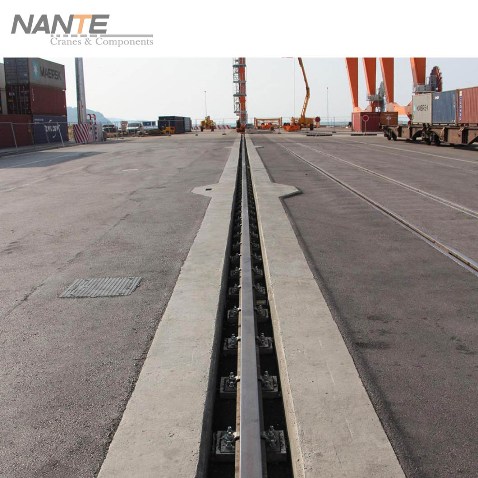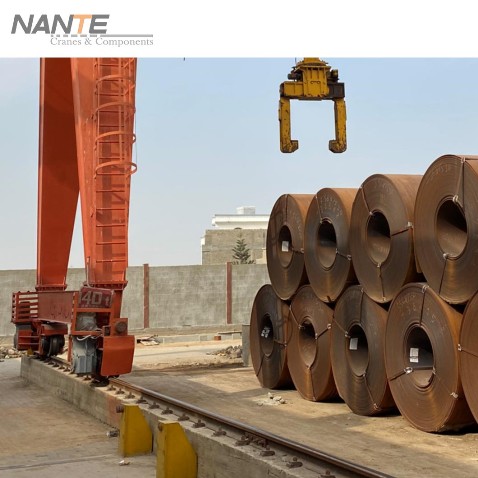An Important Device for Crane Movement – Crane Rail
Date: 2024-02-26 Share:
An Important Device for Crane Movement – Crane Rail
Crane rail is an important part of the normal operation of the crane, mainly used to support and guide the movement of the crane. It is a kind of heavy-duty rail, which can withstand the huge pressure and friction generated by the crane operation. Crane rails are indispensable equipment in the field of industry and construction, especially in places where heavy loads need to be handled and moved frequently.
Crane rails are usually made of high-carbon steel, which has high strength and wear resistance. Crane rails have a wider upper flange and a narrower lower flange, which allows them to withstand loads in both vertical and horizontal directions. In addition, the gauge of the crane rail (i.e. the distance between the two rails) needs to be adjusted according to the wheelbase of the crane to ensure the smooth operation of the crane.

Components of crane rail
The components of crane rail include steel rail, rail clamp, fishplate, rail pad and other components. Each of these components plays an important role in ensuring the stability and safety of the crane rail.
Steel Rail:
Steel rail is the main load-bearing part of crane rail, usually made of high-strength steel. It bears the weight and impact of the crane operation, so it needs to have enough strength and wear resistance.
Rail Clamp:
Rail clamps are used to secure the rail to the support structure to ensure that the rail does not shift or come loose. Rail clamps are usually bolted or otherwise fastened to the rail and support structure to provide firm support.
Fishplate:
Fishplates are used to connect two sections of rail to ensure continuity and a smooth transition between them. Fishplates have a special shape and design and can be bolted or otherwise fastened to the rail to prevent breakage or misalignment of the rail during crane operation.
Rail Pad:
Rail pads are typically placed between the rails and the supporting structure to reduce vibration and noise and improve the smoothness of the rail. Rail pads can be made of rubber, plastic, or other elastic materials that provide good cushioning and vibration-damping properties.
In addition to the components mentioned above, crane rail may also include other auxiliary components, such as track cleaning devices, track lubrication devices, safety guardrails, etc., to ensure the normal operation and safety of the rail system.
In short, these components together constitute crane rail and each plays an important role. When selecting and installing these components, you need to give full consideration to their load-carrying capacity, wear resistance, installation accuracy and other factors, and at the same time, you need to follow the relevant technical requirements to ensure that their quality and performance meet your use requirements.
Uses of crane rails
Crane rails have a wide range of uses, such as in material handling, in factories, warehouses and other places, crane rails can help cranes to achieve efficient handling and stacking of materials and improve productivity. Regarding the installation and maintenance of equipment, such as in construction sites or industrial equipment, crane rails can be used to install and maintain heavy equipment, reducing the labor intensity of workers. In addition, in bridge and building construction, crane rails can be used for lifting and installing materials such as steel structures and reinforcement bars to improve construction efficiency and quality.
In short, crane rail is an important equipment in the field of industry and construction, which has a wide range of uses and plays an important role in improving productivity and construction quality.

Installation requirements and service life of crane rails
The installation requirements and service life of crane rails are very important, which are introduced separately below.
Installation requirements
The installation quality of crane rail directly affects the stability and safety of crane operation. Therefore, the following requirements need to be followed when installing crane rails.
Firstly, the accuracy of the track size is one of the key requirements for crane rail installation, you must ensure that the straightness and parallelism of the track, and the deviation shall not exceed the specified range.
Secondly, the level of the track is very high, the error range needs to be controlled within the specified range to ensure the smooth operation of the crane.
In addition, the fixing method of the track should be firm and reliable. The level of the track must be maintained during fixing to prevent the bolt holes from shifting.
Finally, the track installation needs to rely on the bearing force of the foundation, so the foundation needs to be processed to ensure that the foundation is flat, hard, and free of loose material to ensure the stability of the track after installation.
Service life
The service life of the crane rail mainly depends on its material, manufacturing process, the use of the environment, maintenance and other factors. Under normal use conditions, the service life of crane rail can reach decades. However, if it is subjected to serious wear and tear, corrosion or impact and other damage, it needs to be replaced in time to ensure the safe operation of the crane.
In order to extend the service life of crane rails, the following measures can be taken. First, select high-quality crane rails to ensure that their materials and manufacturing processes meet the requirements. Second, regular inspection and maintenance of crane rails, timely detection and treatment of potential problems. Third, lubricate the crane rail to reduce friction and wear. Fourthly, avoid impact or excessive pressure on the crane rail.
In short, when installing crane rails, you need to follow the relevant technical requirements and specifications to ensure the quality of installation, so as to protect the safe operation and service life of the crane.
 English
English






